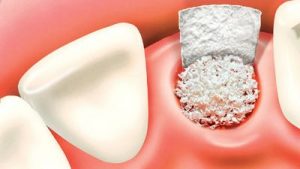
Bone graft and membrane in place after a tooth extraction
Bone grafting is often closely associated with extractions and dental implants. In the majority of cases, the success of an implant or restoration procedure can hinge on the height, depth, and width of the jawbone at the implant site. When the jawbone has receded or sustained significant damage, the implant(s) cannot be supported on this unstable foundation and bone grafting is usually recommended for the ensuing restoration.
There are several major factors that affect jaw bone volume:
- Periodontal Disease – Periodontal disease can affect and permanently damage the jaw bone that supports the teeth. Affected areas progressively worsen until the teeth become unstable.
- Tooth Extraction – Studies have shown that patients who have experienced a tooth extraction subsequently lose 40-50% of the bone surrounding the extraction site during healing. Loss of bone results in what is called a “bone defect”.
- Injuries and Infections – Dental injuries and other physical injuries resulting from a blow to the jaw can cause the bone to recede. Infections can also cause the jaw bone to recede in a similar way.
Reasons for bone grafts
Bone grafting is a highly successful procedure in most cases. It is also a preferable alternative to having missing teeth, diseased teeth, or tooth deformities. Bone grafting can increase the height or width of the jawbone and fill in voids and defects in the bone.
There are essentially two basic ways in which bone grafting can positively impact the health and stability of the teeth:
- Jaw Stabilization – Bone grafting stabilizes and helps restore the jaw foundation for restorative or implant surgery. Deformities can also be corrected and the restructuring of the bone can provide added support.
- Preservation – Bone grafting can be used to limit or prevent bone recession following a tooth extraction, periodontal disease, or other invasive processes.
What Does Bone Grafting Involve?
During the surgery, local anesthetic will be used to numb the grafting and extraction sites. A small incision will be made to prepare the site for the new bone and it will be anchored into place with a synthetic membrane to cover the graft. This membrane prevents soft tissue and bacterial invasions, and encourages new bone growth.
